We had decided to get the train to Zwolle today, a place neither of us had visited. This was also a tactical move. Harlingen was predicted to be wet today, with a band of rain travelling north. The band however petered out further east, so with a bit of luck, we may avoid it.
The leg to Leeuwarden was more forested with wind turbines than what I remembered from earlier years. Our intercity train from Leeuwarden to Rotterdam via Zwolle was packed; reminiscent of some British trains. As per most of Holland, the flat expanse of agricultural land was divided into patchworks by a criss-cross of road networks, canals and ditches. There seemed to be as many canals and ditches as roads.
Water management is a major preoccupation in Holland, and quite rightly so. The Rijkswaterstaat (RWS) and the district water boards are charged with water management in the Netherlands. The RWS is responsible for the management of the major waters, such as the sea and the rivers. RWS ensures that the government authorities responsible are alerted in good time to floods or stormy seas. In addition, RWS maintains dykes, dams, weirs, and storm surge barriers. Furthermore, RWS protects the coast and gives more room to rivers, for example, by deepening floodplains and constructing secondary channels. District water boards are responsible for regional waters, such as canals and polder waterways. For example, they ensure that the water is clean in order to keep fish stock up to par. The district water boards also protect the country from flooding and ensure that farmers have sufficient water for their crops. Furthermore, they are responsible for waste water purification.
 The Stadsgracht, the Moat Around the Historic City |
 The Pelsertoren |
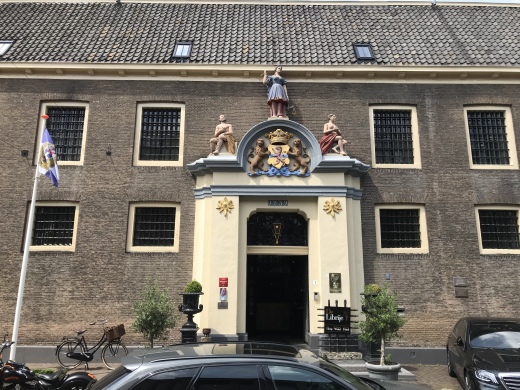 Librije's Hotel and Restaurant |
Zwolle was granted city rights by Bishop Willebrand van Oldenburg of Utrecht in 1230, and over the years it grew into a city of significance, largely because of its favourable position on existing trading routes. In 1407 Zwolle joined the Cologne quarter of the Hanseatic League. As a Hanseatic city, Zwolle experienced its "Golden Age" in the 15th century, and also developed a rich ecclesiastical and cultural history. The Modern Devotion religious reform movement was very active here, and many buildings are reminders of its presence.
 Rex Returning from His Audition at the Theater De Spiegel |
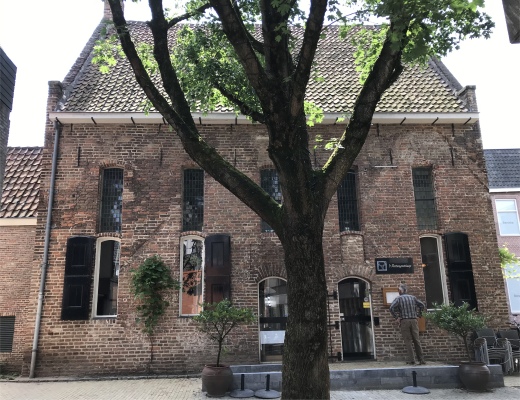 Pestengasthuys (Plague House) |
We crossed the Thorbeckegracht back to the main island and took a short hike to the Weversgildeplein. This brought us to the Pestengasthuys. Here victims of the bubonic plague were brought together and cared for as far as possible. It is not clear whether sufferers from the illness were actually forced to enter the "plague house". After 1660 the plague had run its course in Zwolle. "Het Pestengasthuys" restaurant has been established there since 1996.
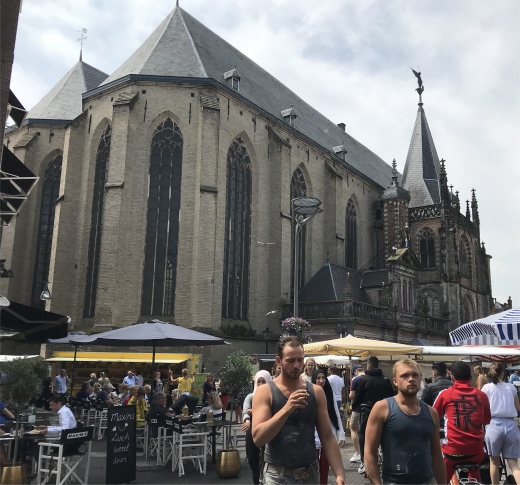 Grote Kerk, or St. Michaelskerk |
 Archangel Michael Glass sculpture |
The original spire was struck by lightning in 1669. Only the church bells survived. Zwolle sold these to the nearby town of Kampen, but at much too high a price. When the people of Kampen realised this, they decided to take their revenge by paying the whole amount in cents. This is why the citizens of Zwolle are known as Blauwvingers (Bluefingers): their fingers had turned blue from counting all the copper coins.
 Pharmacy |
 Gable Stone |
 Onze Lieve Vrouwe Basilica |
Near to the Grote Kerk stood a house with a stepped gable and a non-original gable stone bearing the date 1609. A pharmacy had been established here since 1830.
A slight distance to the west of the Grote Kerk lay the Ossenmarkt, and old cattle market, formerly known as the Onze Lieve Vrouwe Kerkhof and, in the Middle Ages, "De Hof van Zwolle". On the Ossenmarkt stands the Onze Lieve Vrouwe Basilica with its landmark tower, popularly known as the "pepperpot".
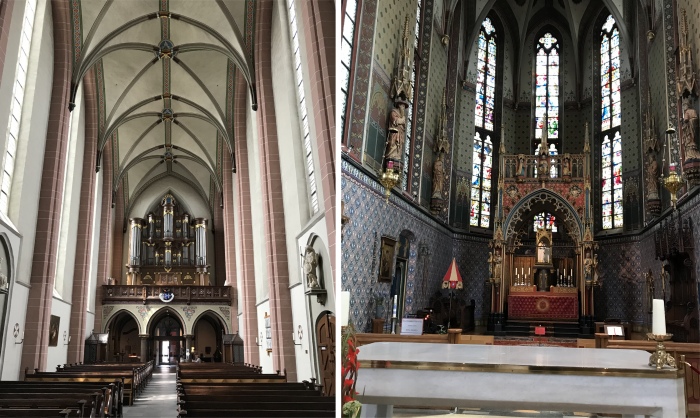 Interior of the Basilica |
The tower, constructed around 1484, was rebuilt with a lantern in 1828 following a fire in 1815, when it was given its present roof, to which it owes its name of the "pepperpot". The carillon contains 51 bells, four of which serve to chime the hours.
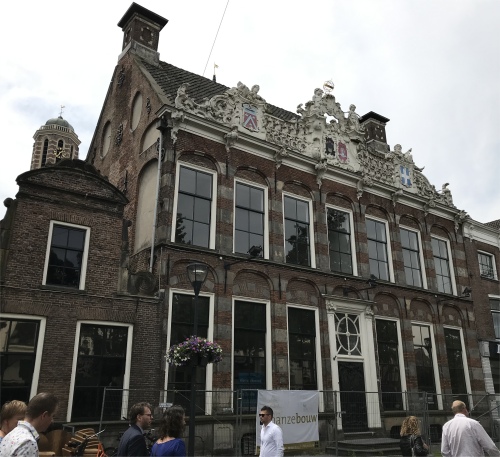 Stedelijk Museum Zwolle |
 Vrouwenhuis |
 Synagogue |
Suitably refreshed, we hiked across town, passing on the way the Synagogue, built in 1898 to a design by F. C. Koch. This third synagogue of the Jewish community of Zwolle was inaugurated in 1899. The gable stone shows the Star of David with the Hebrew inscription "My house shall be called a house of prayer for all peoples" (Isaiah 56:7).
A short walk brought us to the symbol of the city of Zwolle, the city gate, the Sassenpoort. This prominent historic building is part of the Top 100 list of Dutch national monuments. The Sassenpoort was built between 1406 and 1409, using bentheimer sandstone from Germany, Drachenfels trachyte, tuff stone and medieval bricks.
 Sassenpoort |
- Customs and city access: Anyone who wanted to enter the city of Zwolle was checked by the gate keepers. Outward appearances were judged and if necessary goods that were entered had to be checked. Tradesmen needed to buy a token at the toll house.
- Prison: Between 1612 and 1739, the Sassenpoort was used as a prison. There are still some features that show this function; the two tower rooms at the moat side on the second floor are good examples of it.
- Defences: The Sassenpoort was part of the defences of Zwolle which received city rights in 1230, enabling it to defend itself. There was a city wall with seven gates, most of which were demolished between 1829 and 1849. The Sassenpoort is the only city gate that was spared such a fate.
- Archives: The Sassenpoort was saved thanks to Victor de Stuers (MP) and the well-known architect Pierre Cuypers (known for the Rijksmuseum and Centraal Railway Station, both in Amsterdam). The gate was handed over to the National Authorities. During the immense renovation at the end of the 19th century, the gate was transformed into a place where both local and regional departments of national archives were housed (until respectively 1912 and 1977).
The building was open to the public, so we naturally entered. The man on reception gave us an excellent account of the gate's history in impeccable English, which I complemented him on. "I worked for a British company, Reuters, on financial news for over 20 years, in Amsterdam," he informed us. He lived in Zwolle and preferred to suffer the daily commute which took over an hour in each direction.
He pointed out that during the 15th century, Zwolle was an important trading town connecting the rest of Holland and Germany with the Baltic. Indeed three rivers passed through the city. The Baltic trade was more important than the trade with the East Indies. However, over time Amsterdam grew from nothing and took over the national lead. He also went on to explain how a lot of effort was being expended on flood defences. Germany was "straightening" out its rivers, with the consequence that they were arriving into Holland with much greater flow rates. He gave a summary of what we would find on the four floors of the 42m high tower, then off we went to explore.
- The Hanze room: at entrance level contained stained-glass pictures of the coats of arms of several cities in the province of Overijssel. Three city maps illustrated how Zwolle's defences changed over time.
- The Pierre Cuypers room: on the next floor contained examples of prison cells. An axle and chain wheel here allowed a portcullis below to be raised and lowered. Murder holes also allowed defenders to throw boiling tar, oil or water on enemy below.
- The Gunpowder room: contained quite a lot of wooden filing cabinets of the local archives (1897-1912).
- The Clock room: on the top floor shows significant details of the building history of the gate.
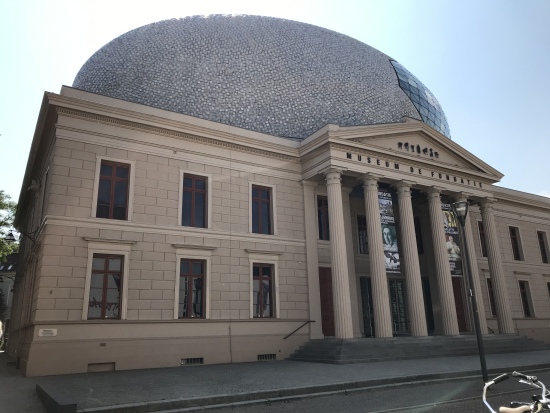 Museum de Fundatie |
After 4.5 hours of exploration, we had had enough. The day had remained bright for us with just a few cloudy intervals, however rain clouds were sweeping in. As we boarded the train back to Leeuwarden, tell-tale drops were falling on the windows. Fortunately Rex spotted that in our carriage, the word SILENCE was etched on the windows. We had come across this before, and Rex fought hard to keep quiet. He was annoyed though at the chap in front of us noisily eating crisps. Hmmm.... just as well Rex hadn't eaten a kilo of sprouts I thought.
We stepped off the train in Harlingen to glorious rain: surprise, surprise. In the evening we enjoyed a Chinese meal. The young Dutch lad who was serving us spoke excellent English, but periodically he had to check back to his Indonesian boss when we raised questions about the dishes that he couldn't answer. He had recently spent 6 months in Japan in connection with his studies. The meal was excellent.
On our way back to Duonita, we popped into 't Lichtboei, where in the bar, Rex got chatting with a guy who spoke reasonable English. It transpired he had an English passport. He originally came from northwest Yorkshire, but his parents moved to Holland for work when he was 8 years old; now he was 38 years old.
A younger lad joined us, Dutch, but spoke good English. He explained how at one time he had conducted maritime studies, resulting in him working on the DFDS ferry that runs between Newcastle and Ijmuiden. However, he met a girl who did not take too well to him disappearing off to sea, so he dropped that line of work. He moved the topic of conversation on to his inoperable little finger on his right hand. He related how he had been injured by a roof tile falling on it. There again he did a lot of boxing, so he could have aggravated the injury there. Eventually his tale of woe concerning his finger became boring ..... time to make an exit.
